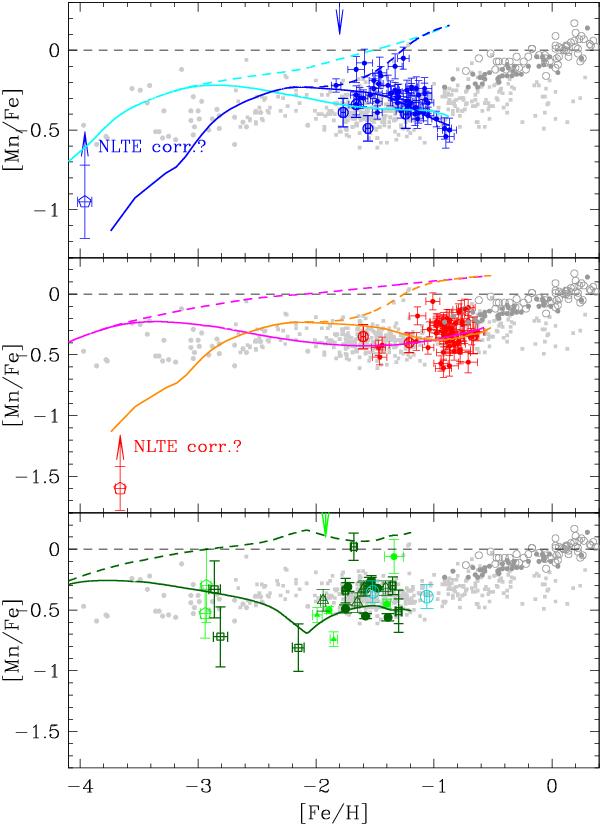Fig. 3

The relation between [Mn/Fe] and [Fe/H]. Data: each dSph galaxy is shown with a different color: blue stands for Sculptor, red for Fornax, green for Sextans, dark green for Carina, and dark turquoise for Leo I. The two green triangles identify the Sextans stars S05-010 and S08-038, whose Mn abundances are based on the λ5432 line only. The colored filled circles identify the samples analyzed in this work; the open symbols stand for previous published analyzes. The four open pentagons at [Fe/H] ≲ −2.9 are from Tafelmeyer et al. (2010) and are corrected for the HFS. The attached arrows gives an idea of the NLTE correction that they likely need, + 0.44, as computed by Bergemann & Gehren (2008) for the halo giant HD 122563. The results of Shetrone et al. (2003) for Sculptor, Fornax, and Leo I are displayed with open circles, and for Carina with open triangles. The dark green open squares are the Carina results of Venn et al. (2012). The dark gray open and filled circles represent the Feltzing et al. (2007) Milky Way thin and thick disk stars, respectively. The Sobeck et al. (2006) Milky Way cluster and field halo stars are shown with full gray squares; gray dots are very metal poor stars in the Milky Way halo from Cayrel et al. (2004). The vertical blue and green downward arrows indicate the “knee”, where [Mg/Fe] starts to decrease with increasing [Fe/H], in the Sculptor and Sextans dSphs (DART). Models: the chemical evolutions of the Sculptor (model A in cyan and model B in blue, see text), Fornax (model C in magenta and model D in orange, see text), and Carina (model E in dark green) dSphs are followed. The continuous lines show models with metallicity-dependent SNe Ia Mn yields as in Cescutti et al. (2008). The dashed lines follow the evolution of [Mn/Fe] for the same SFHs, but with metal-independent SNe Ia Mn yields.
Current usage metrics show cumulative count of Article Views (full-text article views including HTML views, PDF and ePub downloads, according to the available data) and Abstracts Views on Vision4Press platform.
Data correspond to usage on the plateform after 2015. The current usage metrics is available 48-96 hours after online publication and is updated daily on week days.
Initial download of the metrics may take a while.


